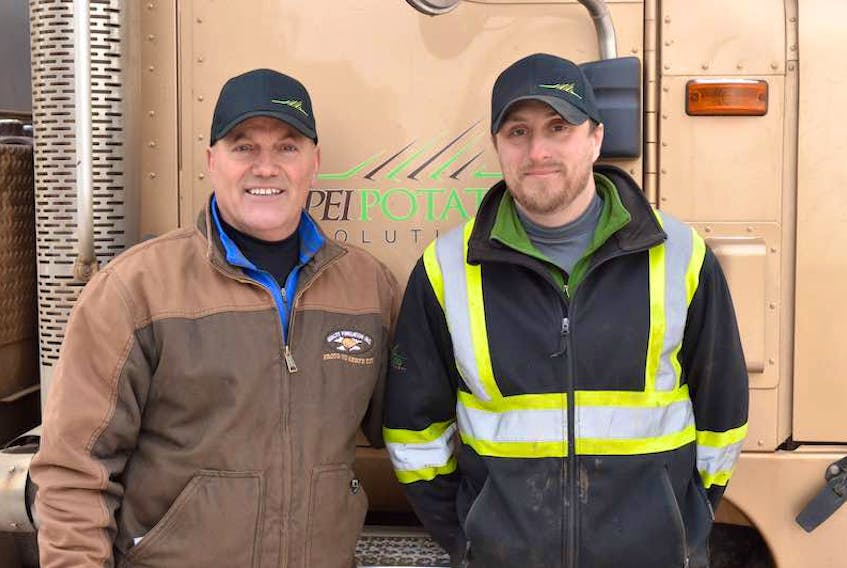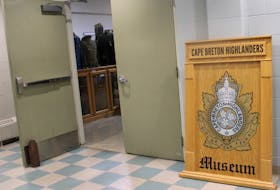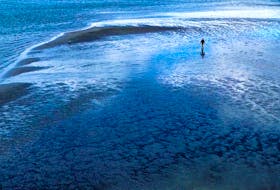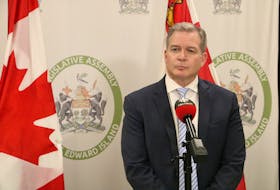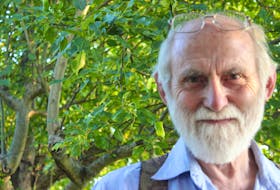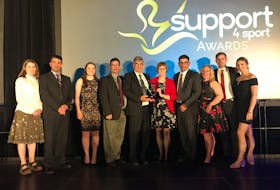TRAVELLERS REST, P.E.I. — A Travellers Rest business has taken responsibility for a recent wastewater spill and is working to make sure it never happens again.
The spill was noticed on Dec. 27, when Chris Wall, who lives in the adjacent community of New Annan, saw that the stream on his property was filled with smelly, grey water.
“Seventy-five feet from the brook, I could smell the potato leachate,” said Wall, whose property is more than a kilometre from P.E.I. Potato Solutions, which has offered washing and sorting services to farmers across the Island since 2014.
Wall snapped photos showing what he described as an unusual, thick, grey cloud of material in the stream, a tributary to the Barbara Weit River.
He immediately suspected the wash plant and went directly to the culvert that exits the property, where he photographed dirty water flowing off-site.
Wall reported what he saw to the Department of Environment.

Tour of plant
P.E.I. Potato Solutions co-owner Austin Roberts can’t believe the spill happened.
He was responsible for the plant on Dec. 26 while facility manager Chris Hunt took his first vacation since August.
“It was mis-management on my part,” said Roberts, who, along with Hunt, invited The Guardian to tour the facility on Jan. 8 to see what happened and what they’re doing to prevent future mishaps.
The culvert Wall and others are concerned about is supposed to only carry rainwater runoff from parking areas and from building roofs.
The rainwater is directed into a grassy ditch along the centre of the property and eventually into the culvert.
However, on Dec. 26, one of the holding ponds farthest from the Confederation Trail overflowed, sending the wash plant by-product into the ditch and out the culvert.

Making it right
Heavy equipment went to work immediately scooping out soil from all six holding ponds.
By Jan. 8, the water levels in the ponds had all been lowered so that there was at least one meter between the ponds’ edges and the water surface. Roberts has also installed silt fencing in the rainwater drainage ditch and has begun taking proper measurements in the holding ponds each day.
Wall, however, has been concerned about the discharge for years and wants the culvert removed altogether. He suspects this is not the first time that pond water has escaped via the culvert. He also suspects it contains pollutants like fertilizer and pesticide residues, as well as potato diseases, which then get washed into the nearby landscape.
“The river pays the price,” said the long-time river watcher.
Roberts and Hunt said any washing they do with diseased soil or potatoes from off-Island is supervised by inspectors from the Canadian Food Inspection Agency (CFIA). They said that wastewater is collected and boiled to destroy any potential pathogens like bacteria, potato wart or nematodes before it is released into the holding ponds.
Despite the strict rules they follow every day, Roberts and Hunt understand the community’s concerns.
They are proud of the work they do, but they aren’t happy with how they’re currently doing it.
The odour from the organic matter in the ponds, as well as dust, has been a frequent issue for the community and one Roberts takes seriously.
“The neighbours have been very patient,” he said, referring to the smell, as well as the dust from the recent construction.

New facility
Soon – Roberts hopes by February – P.E.I. Potato Solutions will be operating in a new, 26,600-square-foot facility, and the stinky ponds will be a thing of the past.
Right now, the plant has 1.2 million gallons of wastewater in the six outdoor ponds.
The new operation will recirculate just 35,000 gallons of water in total, and all parts of the process will be indoors to control odour and dust.
The holding ponds will be replaced by two stainless steel tanks, though one empty pond will remain as an emergency backup.
The new facility will increase production, reduce labour costs and improve working conditions, but Roberts said the whole idea is to fix the challenges of handling the byproducts – the dirty wash water, the odour and the dust.
This isn’t the first time the plant has faced a turning point due to its byproducts. In 2014, soon after opening, the plant was shut down for a week after tests showed too many suspended solids in wastewater.
That’s when the settling ponds were built. Roberts said the plant has continued to adapt its practices to manage the byproducts ever since. The new plant will turn over a new leaf.
“This is where it starts taking us up to a whole new level,” said Roberts.
Following up on the recent overflow, provincial environment officials have been on site regularly since Dec. 27. Three water samples were taken – two from near the culvert and one from the brook on Wall’s property. The results aren’t back yet.
A written statement from the Department of Environment said inspections will continue until the work has been completed.
Inspection is nothing new for Roberts. They’re used to the scrutiny – from officials at the province and the federal Canadian Food Inspection Agency, as well as the neighbours.
Roberts and Hunt hope the new plant will make them a better corporate citizen in the community.
“You can’t say you’re supporting the farmers and then ignore your neighbours,” Roberts said and gestured to the construction. “This is the proof.”

At a glance
Here’s what it takes to wash potatoes by the truckload:
- Dry dirt extraction - potatoes tumbled to loosen dirt
- Rock extraction - potatoes are floated through a trough of water, rocks fall to bottom
- Wash barrel - potatoes are tumbled in a large drum and sprayed with recycled water
- Drying table - absorbent rollers suck up extra water
- Scanners - optical and chemical scanners look at and beneath the surface to pick out debris and sub-par spuds
- Metal detector - to pick out any metal objects embedded in the potatoes
- Sizing - separates potatoes by size
- Storage bins - keep potatoes until truck takes them to processor
The process makes sure each potato in the load is a good one which maximizes returns for the farmer. Even if a pile in storage “starts to go bad” the plant can pick out rotten spuds so the crop can be sold.
Alison Jenkins is a local journalism initiative reporter, a position funded by the federal government.

